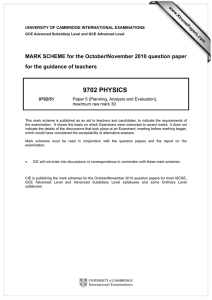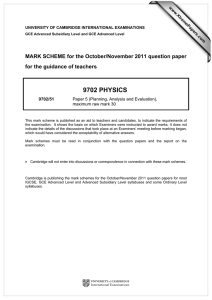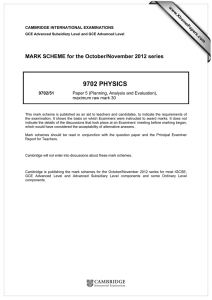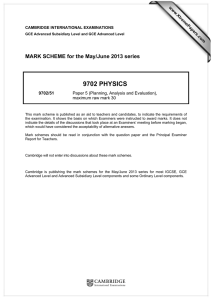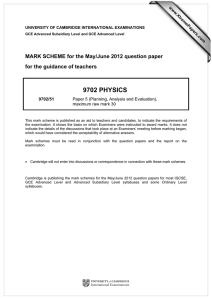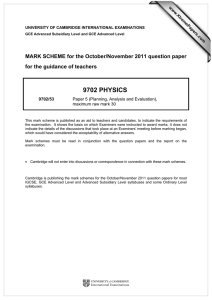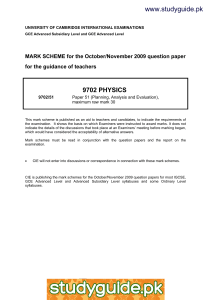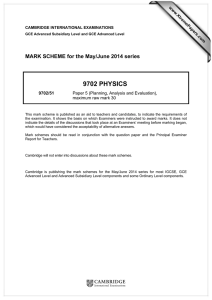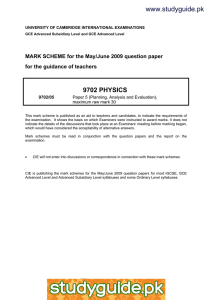www.studyguide.pk 9702 PHYSICS
advertisement
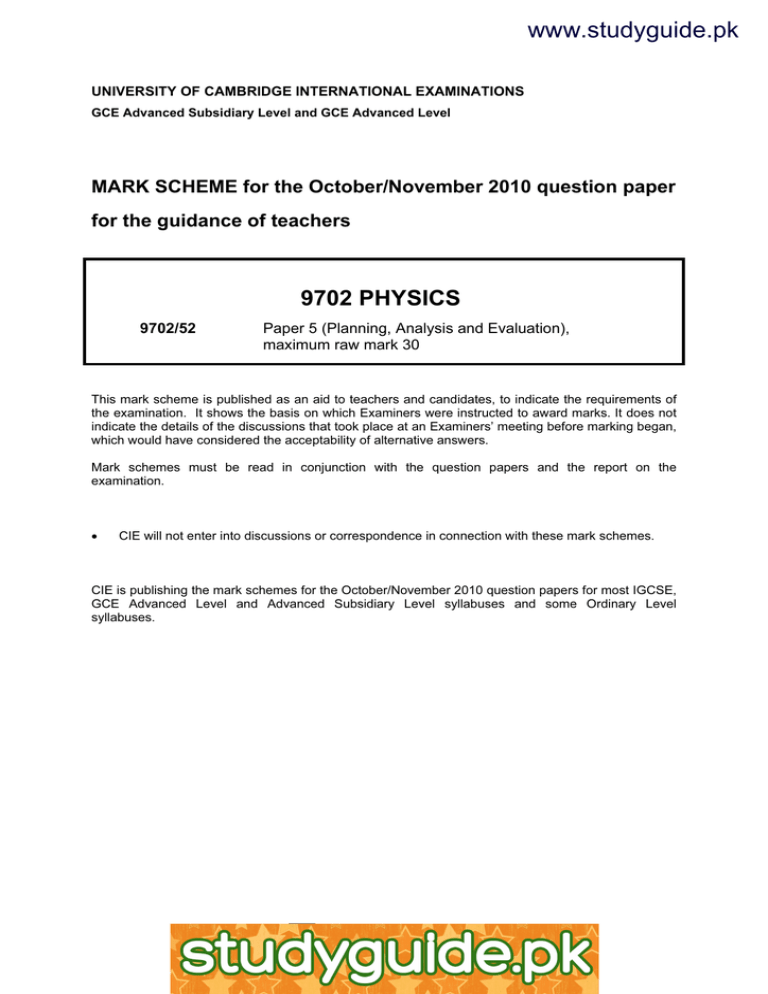
www.studyguide.pk UNIVERSITY OF CAMBRIDGE INTERNATIONAL EXAMINATIONS GCE Advanced Subsidiary Level and GCE Advanced Level MARK SCHEME for the October/November 2010 question paper for the guidance of teachers 9702 PHYSICS 9702/52 Paper 5 (Planning, Analysis and Evaluation), maximum raw mark 30 This mark scheme is published as an aid to teachers and candidates, to indicate the requirements of the examination. It shows the basis on which Examiners were instructed to award marks. It does not indicate the details of the discussions that took place at an Examiners’ meeting before marking began, which would have considered the acceptability of alternative answers. Mark schemes must be read in conjunction with the question papers and the report on the examination. • CIE will not enter into discussions or correspondence in connection with these mark schemes. CIE is publishing the mark schemes for the October/November 2010 question papers for most IGCSE, GCE Advanced Level and Advanced Subsidiary Level syllabuses and some Ordinary Level syllabuses. www.XtremePapers.net www.studyguide.pk Page 2 1 Mark Scheme: Teachers’ version GCE A/AS LEVEL – October/November 2010 Syllabus 9702 Paper 52 Planning (15 marks) Defining the problem (3 marks) P1 f is the independent variable and V is the dependent variable or vary f and measure V P2 Keep the current in coil X constant P3 Keep the number of turns on coil (Y)/area of coil Y constant Do not credit reference to coil X only. [1] [1] [1] Methods of data collection (5 marks) M1 Two independent coils labelled X and Y. M2 Alternating power supply/signal generator connected to coil X in a workable circuit. M3 Coil Y connected to voltmeter/c.r.o. in a workable circuit. M4 Use c.r.o. to determine period/frequency or read off signal generator. M5 Method to keep current constant in coil X: adjust signal generator/use of rheostat. [1] [1] [1] [1] [1] Method of analysis (2 marks) A1 Plot a graph of V against f. A2 Relationship valid if straight line through origin [1] [1] Safety considerations (1 mark) S1 Reference to hot coils – switch off when not in use/use gloves/do not touch coils. Must refer to hot coils. [1] Additional detail (4 marks) D1/2/3/4 Relevant points might include 1. 2. 3. 4. 5. 6. 7. 8. [4] Use large current in coil X/large number of coils on coil Y (to increase emf). Use iron core (to increase emf). Detail on measuring emf e.g. height × y-gain. Avoid other alternating magnetic fields. Detail on measuring frequency from c.r.o. to determine period and hence f. Use of ammeter/c.r.o. and resistor to check current is constant Use insulated wire for coils. Keep coil Y and coil X in the same relative positions. Do not allow vague computer methods. [Total: 15] © UCLES 2010 www.XtremePapers.net www.studyguide.pk Page 3 2 Mark Scheme: Teachers’ version GCE A/AS LEVEL – October/November 2010 Syllabus 9702 Paper 52 Analysis, conclusions and evaluation (15 marks) Part Mark Expected Answer Additional Guidance (a) A1 Gradient = b y-intercept = lg a Allow log a but not ln a (b) T1 T2 1.9777 0.292 or 0.2923 1.9294 0.265 or 0.2648 1.8751 0.241 or 0.2405 1.8129 0.210 or 0.2095 1.7404 0.170 or 0.1703 1.6532 0.127 or 0.1271 T1 for lg l column – ignore rounding errors; min 2 dp. T2 for lg T column – must be values given A mixture is allowed From ± 0.004 or ± 0.005 to ± 0.006 or ± 0.007 Allow more than one significant figure. Six points plotted correctly Must be within half a small square; penalise ≥ half a small square. Penalise ‘blobs’ ≥ half a small square. Ecf allowed from table. Error bars in lg (T/s) plotted correctly. All error bars must be plotted. Check first and last point. Must be accurate within half a small square; penalise ≥ half a small square. Line of best fit If points are plotted correctly then lower end of line should pass between (1.65, 0.124) and (1.65, 0.128) and upper end of line should pass between (2.00, 0.300) and (2.00, 0.306). Allow ecf from points plotted incorrectly; five trend plots needed – examiner judgement. Worst acceptable straight line. Steepest or shallowest possible line that passes through all the error bars. Line should be clearly labelled or dashed. Should pass from top of top error bar to bottom of bottom error bar or bottom of top error bar to top of bottom error bar. Mark scored only if all error bars are plotted. (iii) C1 Gradient of best fit line The triangle used should be at least half the length of the drawn line. Check the read offs. Work to half a small square; penalise ≥ half a small square. U3 Uncertainty in gradient Method of determining absolute uncertainty Difference in worst gradient and gradient. y-intercept Must be negative. Check substitution of point from line into c = y – mx. Allow ecf from (c)(iii). U1 (c) (i) G1 U2 (ii) G2 G3 (iv) C2 © UCLES 2010 www.XtremePapers.net www.studyguide.pk Page 4 (d) Mark Scheme: Teachers’ version GCE A/AS LEVEL – October/November 2010 Syllabus 9702 Paper 52 U4 Uncertainty in y-intercept Method of determining absolute uncertainty Difference in worst y-intercept and y-intercept. Do not allow ecf from false origin read-off (FOX). Allow ecf from (c)(iv). C3 a = 10y-intercept y-intercept must be used. Expect an answer of about 0.19. If FOX expect answer of about 1.3. C4 b = gradient and in the range 0.495 to 0.520 and to 2 or 3 sf Allow 0.50 to 0.52 to 2 sf Penalise 1 sf or ≥4 sf U5 Absolute uncertainty in a and b Difference in a and worst a. Uncertainty in b should be the same as the uncertainty in the gradient. [Total: 15] Uncertainties in Question 2 (c) (iii) Gradient [U3] 1. Uncertainty = gradient of line of best fit – gradient of worst acceptable line 2. Uncertainty = ½ (steepest worst line gradient – shallowest worst line gradient) (c) (iv) [U4] 1. Uncertainty = y-intercept of line of best fit – y-intercept of worst acceptable line 2. Uncertainty = ½ (y-intercept of steepest worst line – y-intercept of shallowest worst line) (d) [U5] 1. Uncertainty = 10 best y-intercept - 10 worst y-intercept © UCLES 2010 www.XtremePapers.net
